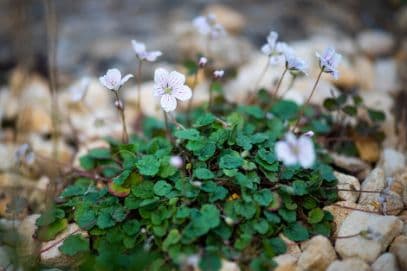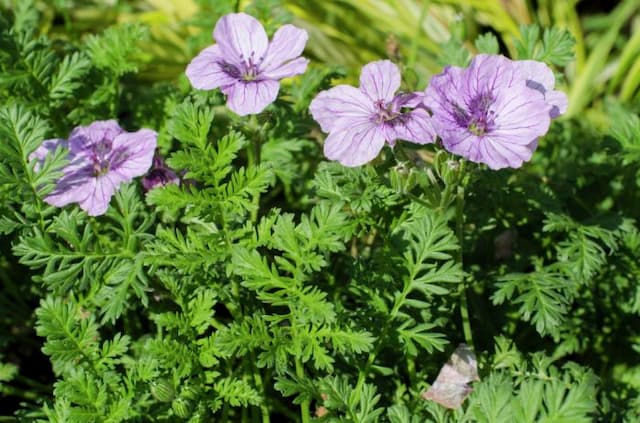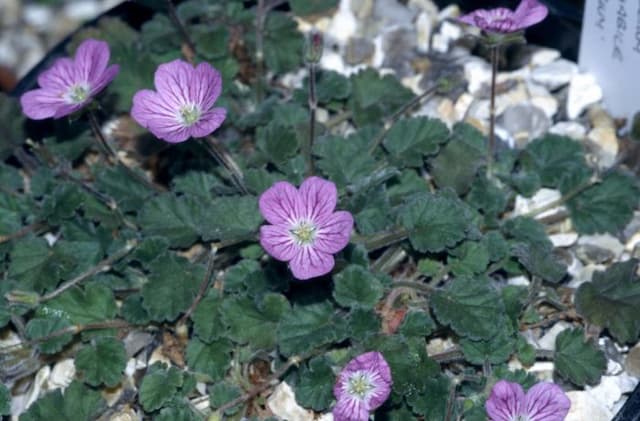Bloody Cranesbill Geranium sanguineum 'Glenluce'

ABOUT
The Geranium sanguineum 'Glenluce', commonly known as Bloody Cranesbill, is characterized by its vibrant and striking flowers and lush foliage. The flowers are notable for their bright magenta-pink hues that seem to radiate warmth and color, making them a focal point of the plant. These blooms typically possess five rounded petals that form a cup-like shape, giving a somewhat ruffled appearance. At the center of each flower, a network of darker pink veins can be observed, which adds to the visual interest and gives the flowers a textured look. Hovering above the greenery, the flowers form clusters that can give a showy display throughout its blooming season. The foliage of the Bloody Cranesbill 'Glenluce' is equally attractive, comprising deeply lobed leaves that offer a rich green backdrop to the luminous flowers. The leaves have a soft appearance but with a slightly serrated edge, imparting a delicate yet hearty presence. The overall effect of the foliage is to create a dense, rounded mound, lush and full, which serves as a perfect complement to the lighter and more vivid flowers that dance above it. This rich tapestry of color and texture can add a splash of charm to any garden setup, making the Bloody Cranesbill 'Glenluce' a beloved choice for garden enthusiasts seeking a robust and eye-catching perennial.
About this plant
 Names
NamesSynonyms
Bloody Cranesbill, Glenluce Cranesbill.
Common names
Geranium sanguineum 'Glenluce'.
 Toxicity
ToxicityTo humans
The hardy geranium, specifically Geranium sanguineum 'Glenluce', is not known to be toxic to humans. In fact, members of the Geranium genus are generally considered non-toxic and are often used in gardens without concern for human health. Ingestion of any part of these plants is not expected to result in poisoning or produce harmful symptoms in humans.
To pets
The hardy geranium, which includes Geranium sanguineum 'Glenluce', is also not known to be toxic to pets such as dogs and cats. These plants are widely regarded as safe for pets, and ingestion typically does not lead to any adverse health effects or poisoning symptoms. Pet owners can usually include these plants in their gardens without significant concern for the safety of their animals.
 Characteristics
CharacteristicsLife cycle
Perennials
Foliage type
Deciduous
Color of leaves
Green
Flower color
Pink
Height
1 foot [30 cm]
Spread
1-2 feet [30-60 cm]
Plant type
Herb
Hardiness zones
4
Native area
Europe
Benefits
 General Benefits
General Benefits- Attracts Pollinators: Geranium 'Glenluce' can attract bees and butterflies, promoting pollination in the garden.
- Low Maintenance: This hardy perennial requires minimal care once established, making it suitable for gardeners of all skill levels.
- Drought Resistant: After establishment, it can tolerate periods of dry weather, reducing the need for frequent watering.
- Ground Cover: With its spreading habit, it provides excellent ground cover, suppressing weeds and reducing soil erosion.
- Ornamental Qualities: Features attractive, vibrant pink flowers and deeply lobed leaves, enhancing the visual appeal of the garden.
- Seasonal Interest: Offers a long blooming season from late spring to early summer, adding color to the garden when many other plants are not in bloom.
- Wildlife Friendly: It can serve as a habitat for small wildlife, enriching biodiversity within its environment.
- Container Gardening: Suitable for pots and containers, it enables gardeners with limited space to enjoy its beauty.
- Border Planting: Its mounding form and colorful blooms make it an excellent choice for borders and edging in garden designs.
- Rabbit Resistant: Generally resistant to rabbit damage, which is beneficial for gardens prone to visits from these animals.
 Medical Properties
Medical Properties- Astringent: Geranium sanguineum, commonly known as bloody cranesbill, has been traditionally used for its astringent properties to help tighten and tone skin.
- Anti-inflammatory: The plant contains compounds that are thought to offer anti-inflammatory benefits.
- Diuretic: Historically, bloody cranesbill has been used to promote the production of urine, thereby potentially aiding in the elimination of waste from the body.
- Antidiarrheal: Due to its astringent properties, it's been traditionally used to help reduce diarrhea by tightening intestinal tissues.
- Antihemorrhagic: Geranium sanguineum has been used in folk medicine to control internal bleeding and heavy menstrual bleeding.
- Other traditional uses include treatment of sore throats, gum diseases, and as a remedy for gastrointestinal issues.
 Air-purifying Qualities
Air-purifying QualitiesThis plant is not specifically known for air purifying qualities.
 Other Uses
Other Uses- As a natural fabric dye: The petals and leaves of Geranium sanguineum can be used to create a range of natural dyes for coloring textiles, often resulting in variations of pink, red, and green hues.
- In artistic crafts: Pressed Geranium sanguineum flowers are sometimes incorporated into creative craft projects, such as handmade paper, bookmarks, or floral decoupage art.
- As a culinary decoration: While not commonly consumed, the vibrant blooms can be used as an edible garnish to add color to salads or desserts, provided they are free of pesticides.
- In potpourri: Dried Geranium sanguineum petals can contribute a pleasant scent and color when mixed with other dried flowers and spices in homemade potpourri.
- As photography subjects: The charming flowers and foliage of the Geranium sanguineum offer photographers a picturesque subject to capture, particularly in macro photography.
- In garden design: Used in landscape architecture, Geranium sanguineum can provide a useful ground cover or edge plant because of its low-growing habit and attractive foliage.
- For teaching botany: Geranium sanguineum can be used as a specimen plant in educational settings, to illustrate principles of plant growth, reproduction, or garden design to students.
- In aromatherapy products: Though not a primary source, the leaves of Geranium sanguineum may sometimes be used to infuse oils with its subtle fragrance for use in homemade aromatherapy blends.
- As a natural pest repellent: Some gardeners plant Geranium sanguineum in an attempt to deter certain pests, as some species of geranium are thought to have repellent properties.
- In celebration of events: The Geranium sanguineum, with its bright and cheerful appearance, can be used to adorn venues for events such as weddings or garden parties, either in arrangements or as living decorations.
Interesting Facts
 Feng Shui
Feng ShuiThe Cranesbill is not used in Feng Shui practice.
 Zodiac Sign Compitability
Zodiac Sign CompitabilityThe Cranesbill is not used in astrology practice.
 Plant Symbolism
Plant Symbolism- Healing: Geraniums are often associated with health and healing, possibly because of their use in traditional medicine and aromatherapy.
- Friendship: Offering a geranium plant or flower can symbolize a wish for deeper friendship or to express the joy that a friend brings into one's life.
- Fertility: In some cultures, geraniums symbolize fertility and reproduction, due to their prolific blooming and ability to easily propagate.
- Happiness and Positive Emotions: With its bright flowers, the geranium is commonly seen as a bearer of happiness, cheerfulness, and positive emotions.
- Protection: Geraniums are believed to ward off negative energies and were historically used to protect against evil spirits.
 Water
WaterThe Bloody Cranesbill, commonly known as the Geranium sanguineum 'Glenluce', should be watered deeply once a week during the active growing season, ensuring that the soil remains moist but not waterlogged. In hotter, drier periods, increase watering frequency to twice a week. During winter, reduce watering to every other week or less, depending on the climate and indoor conditions. Whenever watering, aim for about one inch of water, which equates to approximately 0.6 gallons per square foot of soil area to ensure deep soil penetration.
 Light
LightFor the Bloody Cranesbill, it thrives in full sun to partial shade. The ideal spot for this plant would be a location where it receives at least six hours of sunlight daily, but it can also tolerate some shade, especially during the hottest part of the day. Avoid deep shade as it can lead to leggy growth and fewer flowers.
 Temperature
TemperatureThe Bloody Cranesbill prefers temperate conditions and can survive in temperatures ranging from around 65°F to 75°F. It can tolerate minimum temperatures down to about 40°F and maximum temperatures up to around 80°F. Ensuring that it is not exposed to extreme cold or heat is crucial for its overall health and flowering.
 Pruning
PruningPruning the Bloody Cranesbill is important to maintain its shape and encourage bushier growth. Prune lightly after the first flush of flowers to stimulate a second bloom. Do more extensive pruning in early spring to remove dead leaves and stems, which will also help prevent disease. Pruning is typically done once or twice a year, depending on the plant's performance and aesthetic requirements.
 Cleaning
CleaningAs needed
 Soil
SoilThe best soil mix for Bloody Cranesbill (Geranium sanguineum 'Glenluce') is well-draining soil enriched with organic matter. A mixture of garden soil, compost, and gritty material like perlite or coarse sand is ideal. The soil pH should be neutral to slightly acidic, ranging between 5.8 and 6.8 for optimal growth.
 Repotting
RepottingBloody Cranesbill doesn't need frequent repotting as it is a hardy perennial. Repotting every 2-3 years is sufficient to refresh the soil and address any overcrowding. Early spring or autumn is the best time for repotting.
 Humidity & Misting
Humidity & MistingThe Bloody Cranesbill is quite adaptable to various humidity levels and does not require specific humidity adjustments. Average room humidity is generally sufficient for healthy growth.
 Suitable locations
Suitable locationsIndoor
Place in bright, indirect light and water when dry.
Outdoor
Plant in part-shade to full sun, in moist soil.
Hardiness zone
4-8 USDA
 Life cycle
Life cycleGeranium sanguineum 'Glenluce', commonly known as Bloody Cranesbill, begins its life as a seed, often sown in late winter to early spring. Upon germination, seedlings develop into a rosette of leaves at the soil surface. As the plant matures, it develops a robust root system and sends up flowering stems, which bloom with vivid pink flowers from late spring to midsummer. After pollination, typically by insects, the plant sets seed in beak-like capsules that give the plant its common name. Following seed dispersal in late summer or autumn, the plant may enter a period of dormancy, particularly in colder climates, where it dies back to its roots. The cycle restarts in spring when new growth emerges from the rootstock, continuing the perennial life cycle of the plant.
 Propogation
PropogationPropogation time
Spring-Early Summer
For Geranium sanguineum 'Glenluce', commonly known as Bloody Cranesbill, the most popular method of propagation is by division. This is typically done in the spring or fall when the plant is not in active bloom. To propagate by division, carefully lift the plant from the ground using a garden fork, trying to keep as much of the root ball intact as possible. Gently tease apart the plant clumps into smaller sections, ensuring each section has a good amount of roots and at least a few shoots. Replant the divisions immediately at the same soil depth they were originally growing, spacing them about 12 inches (approximately 30 centimeters) apart to allow for adequate growth and spread. Water the new plants thoroughly to help establish them. Division not only helps in propagating new plants but also rejuvenates older plants that may have become woody or less vigorous.





![Cranesbill [Blue Sunrise]](/_next/image?url=https%3A%2F%2Fplants-admin.emdemapps.com%2Fimages%2Fplants%2F%2Fimages%2F604b638d45948.png&w=640&q=75)



